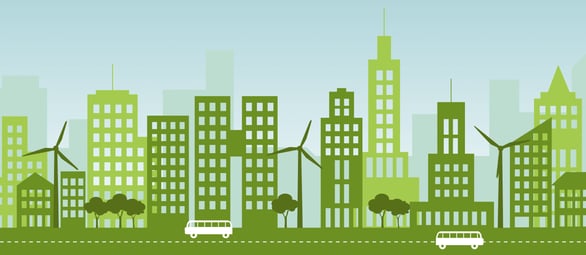Conversations about curbing climate change tend toward one of two extremes, focusing on either what individuals can do or what national governments, acting in concert globally, can do.
Both of these avenues are worthwhile of pursuit. Federal governments can limit industrial emissions, set renewable energy goals, fund necessary infrastructure programs, and enact other high-level policies. Individuals can reduce their carbon footprints and overall reliance on fossil fuels by making even small changes in their daily habits, such as starting a carpool with coworkers.
Often overlooked in the fight against global climate change, however, are cities, towns, and other municipalities. There are important steps that they can implement to further contribute to the cause.
Cities’ Roles
For municipalities, many of which are working hard to maintain public services during challenging economic times, the idea of building an energy management or sustainability program from the ground up can be daunting. To help, the Environmental Protection Agency (EPA) has set up a simple, seven-step guide:
- Make the Commitment — The federal government provides a wealth of resources to help set the foundations for a plan
- Assess Performance — Knowing where and how your municipality is succeeding, or failing, is necessary
- Set Goals — Identify the areas in which your city can ameliorate and set realistic improvement goals
- Create an Action Plan — Work backward to determine the steps required to reach your goals
- Implement the Action Plan — There are no results without action
- Evaluate Progress — As with any project, regular progress evaluations will help keep advancements on track and allow for further adjustments
- Recognize Achievements — Let your constituency know about the work that’s being done and the results that it’s bringing
LEED Certification
One of the most effective ways for towns and cities to increase energy savings is to promote or require Leadership in Energy & Environmental Design (LEED) certifications for all new construction within their borders. They can also lead by example, improving the energy efficiency of municipal buildings.
Requiring energy use reports from building managers and large complexes, offering free energy use assessments to small business owners, and participating in state-run incentive programs — which can include solar energy for public buildings, reimbursement for energy conservation lights and appliances, and more — are all highly effective methods for promoting LEED certifications and other energy saving practices.
Education
It is as important for municipal governments to educate themselves about energy saving practices as it is for their constituents. The federal government, state governments such as New York and Vermont, and other organizations all offer a tremendous volume of resources that you can, and should, tap into.
Remain Engaged
Perhaps the most important thing cities and towns can do to advance their energy efficiency efforts is to remain engaged with their constituents, ensuring that they are properly educated and informed about energy savings techniques. People often want to do their part to help but are simply unfamiliar with how to go about it — in a crowded information and market space, it can be difficult to know which habits to change or which products to purchase.
One way to both educate your constituency and get them started saving energy is with energy savings kits, preassembled packages of informational materials, tools, and products. To learn more about these kits, download AM Conservation Group’s latest eBook, Myths and Facts about Energy Efficiency, for free today.







